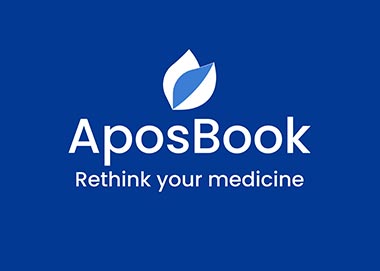Ready to leave?
Oops ! Condition name you have entered is invalid.
You are now leaving Aposbook.com and going to an external site managed by another organization.
Please confirm your email address and try to login again.
This account has been deleted. do you want to restore it?

Validate your email
A verification link will be sent to within the next 2 minutes. Please click it to validate your e mail.
*If you didn't get the link, please check your spam folder
Welcome to Aposbook,
As a registered user, you can benefit from the various free tools and services that we provide.
All you need to do is log in to start discussing with others, interacting, asking questions, and sharing your point of view about the various topics.
You can also write reviews and testimonials about any natural solution you have tried and share your experience. Your feedback can be very helpful.
If you are a health expert, you can add information about any topic or suggest text edit. You can also publish content, including articles and videos, about any topic from the related library section.
Together we can help.
The Aposbook Team
Forgot Password?
A validation link will be sent to you by email. Please confirm your address to log in
*If you didn't get the link, please check your spam folder
Please log in to use this feature
Your account has been suspended because you have violated our code of conduct. If you think this was a mistake, you can contact us by email at: support@aposbook.com "Contact us" form.
Success! Thank you for your feedback. Your contribution can make a difference. Together we can help each other.


Beauty and hygiene
Sunburn
Sunburn: Causes, Risks, Protection, and Natural Treatments
Complete Guide to Sunburn
What is Sunburn
Sunburn occurs when the skin is overexposed to ultraviolet (UV) rays, mainly from the sun or artificial sources like tanning beds. These UV rays penetrate the outer layers of the skin, damaging skin cells and leading to an inflammatory response. Sunburn progresses in stages, starting with redness, followed by pain, and sometimes blisters. In severe cases, the skin peels as part of the healing process.
Under normal conditions, the skin serves as a protective barrier. It consists ...
What is Sunburn
Sunburn occurs when the skin is overexposed to ultraviolet (UV) rays, mainly from the sun or artificial sources like tanning beds. These UV rays penetrate the outer layers of the skin, damaging skin cells and leading to an inflammatory response. Sunburn progresses in stages, starting with redness, followed by pain, and sometimes blisters. In severe cases, the skin peels as part of the healing process.
Under normal conditions, the skin serves as a protective barrier. It consists of three layers:
- Epidermis: The outermost layer that shields the body from external elements.
- Dermis: The middle layer, containing blood vessels, nerves, and connective tissues.
- Hypodermis: The deepest layer made up of fat and connective tissues.
The skin also maintains moisture balance and repairs minor damage. However, when exposed to excessive UV radiation, the skin’s natural defense is overwhelmed, leading to the burning and damage we see as sunburn.
How Sunburn Develops and Timing
- UV Exposure: Sunburn is caused not by heat but by UV radiation. Sitting in the sun for short periods (e.g., 2 minutes) is unlikely to cause a burn unless the UV index is very high. Most people can start to burn in as little as 15 minutes of direct sun exposure, depending on the UV strength, but factors like fair skin or high altitudes increase vulnerability.
- Temperature and UV Index: UV rays are more intense during midday (10 AM to 4 PM) and in areas closer to the equator or at higher altitudes. UV radiation is the primary cause of sunburn, not the heat itself, so temperature doesn’t directly determine if you’ll get sunburned. However, stronger sunlight and clear skies increase UV intensity.
- Severity Based on Time and Protection: Without sun protection like sunscreen, you may experience mild sunburn after just 15–30 minutes of exposure. Severe burns can occur after a few hours. Using sunscreen with SPF 30 or higher, wearing protective clothing, and seeking shade can significantly reduce this risk.
- Cellular Damage and Inflammation: UV rays damage the DNA in skin cells, causing inflammation. As blood flow increases to the affected area, redness and tenderness begin, typically 4–6 hours after exposure.
- Blisters and Fluid Release: In severe cases, the skin’s outer layer splits, leading to fluid-filled blisters as the body attempts to protect the underlying tissue.
- Peeling: Over the next several days, damaged skin cells die and peel off, allowing new cells to take their place.
Stages of Sunburn
1. Mild sunburn: Redness and discomfort without blistering.
2. Moderate sunburn: Redness, pain, and swelling.
3. Severe sunburn: Intense redness, swelling, blisters, and peeling skin.
The time it takes for sunburn to develop varies, but symptoms typically start to appear within 4–6 hours after exposure, with the severity peaking at 24 hours. Healing can take several days to a week, depending on the extent of the damage. Severe sunburn can sometimes result in long-term skin damage if left untreated.
Causes of Sunburn
Sunburn results from various factors, primarily UV exposure. Here’s a more detailed explanation of the key causes:
- Prolonged exposure to direct sunlight: Spending long periods outdoors, especially between 10 AM and 4 PM when the sun's UV rays are strongest, can cause sunburn, particularly without proper sun protection like sunscreen or clothing.
- Use of tanning beds: Artificial UV radiation from tanning beds can be even more intense than natural sunlight. Regular or excessive use of tanning beds ...
Causes of Sunburn
Sunburn results from various factors, primarily UV exposure. Here’s a more detailed explanation of the key causes:
- Prolonged exposure to direct sunlight: Spending long periods outdoors, especially between 10 AM and 4 PM when the sun's UV rays are strongest, can cause sunburn, particularly without proper sun protection like sunscreen or clothing.
- Use of tanning beds: Artificial UV radiation from tanning beds can be even more intense than natural sunlight. Regular or excessive use of tanning beds significantly increases the risk of skin damage and sunburn.
- Reflection from surfaces: Certain surfaces, such as water, sand, snow, and concrete, reflect UV rays, intensifying exposure and increasing the likelihood of sunburn, even in shaded areas.
- Thin ozone layer: The depletion of the ozone layer in some regions allows more UV radiation to reach the earth’s surface, raising the risk of sunburn, especially at higher altitudes or closer to the poles.
These causes contribute to increased UV exposure and the likelihood of sunburn without adequate protective measures.
Sunburn Risk Factors
Certain factors can make individuals more susceptible to sunburn. These risk factors don’t cause sunburn themselves but heighten the chances of developing one.
- Fair or light skin: People with lighter skin have less melanin, making them more susceptible to UV damage.
- Certain medications: Some medications increase the skin’s sensitivity to UV rays, including:
- Antibiotics (e.g., doxycycline, tetracycline)
- NSAIDs (e.g., ibuprofen, naproxen)
- Diuretics
- Antihistamines
- Acne treatments (e.g., isotretinoin)
- Geographical location: Living in areas with intense ...
Sunburn Risk Factors
Certain factors can make individuals more susceptible to sunburn. These risk factors don’t cause sunburn themselves but heighten the chances of developing one.
- Fair or light skin: People with lighter skin have less melanin, making them more susceptible to UV damage.
- Certain medications: Some medications increase the skin’s sensitivity to UV rays, including:
- Antibiotics (e.g., doxycycline, tetracycline)
- NSAIDs (e.g., ibuprofen, naproxen)
- Diuretics
- Antihistamines
- Acne treatments (e.g., isotretinoin)
- Geographical location: Living in areas with intense UV exposure, like near the equator or at high altitudes, increases sunburn risk.
- Frequent outdoor activities: Spending a lot of time outdoors without protection, especially during peak UV hours, heightens the likelihood of sunburn.
Sunburn Symptoms
Sunburn symptoms can range from mild discomfort to more severe reactions, depending on the intensity of the exposure and the individual’s skin type.
- Redness: Skin turns red due to increased blood flow as a response to injury.
- Pain and tenderness: Affected areas become sensitive and painful to the touch.
- Swelling: Inflammation can cause the skin to swell.
- Blisters: Severe burns may cause blisters to form.
- Peeling: As the skin heals, it may peel after several days.
- Headache, fever ...
Sunburn Symptoms
Sunburn symptoms can range from mild discomfort to more severe reactions, depending on the intensity of the exposure and the individual’s skin type.
- Redness: Skin turns red due to increased blood flow as a response to injury.
- Pain and tenderness: Affected areas become sensitive and painful to the touch.
- Swelling: Inflammation can cause the skin to swell.
- Blisters: Severe burns may cause blisters to form.
- Peeling: As the skin heals, it may peel after several days.
- Headache, fever, or nausea: In severe cases, sunburn may lead to systemic symptoms.
Sunburn Diagnosis
Sunburn diagnosis is usually straightforward and based on the visible signs of skin damage after UV exposure. In more severe cases, a healthcare professional may be needed to assess the extent of the damage.
- Visual examination: Redness, swelling, or blisters can be easily identified.
- History of exposure: A history of recent UV exposure helps confirm sunburn.
- Severity assessment: In cases of blistering or systemic symptoms, further evaluation is required.
- Skin type evaluation: Some individuals may need specialized advice ...
Sunburn Diagnosis
Sunburn diagnosis is usually straightforward and based on the visible signs of skin damage after UV exposure. In more severe cases, a healthcare professional may be needed to assess the extent of the damage.
- Visual examination: Redness, swelling, or blisters can be easily identified.
- History of exposure: A history of recent UV exposure helps confirm sunburn.
- Severity assessment: In cases of blistering or systemic symptoms, further evaluation is required.
- Skin type evaluation: Some individuals may need specialized advice based on their skin sensitivity.
Natural Treatments for Sunburn
There are several natural remedies for sunburn aiming to soothe the skin, reduce inflammation, and support recovery through various natural approaches. Click on natural treatments for sunburn to find all the natural solutions to treat sunburn and relieve its symptoms, including various natural therapies, alternative medicine, vitamins, supplements, herbal medicine, and home remedies. You can also go to www.aposbook.com to find all the natural treatments for any medical condition IN ONE CLICK.
Some of ...
Natural Treatments for Sunburn
There are several natural remedies for sunburn aiming to soothe the skin, reduce inflammation, and support recovery through various natural approaches. Click on natural treatments for sunburn to find all the natural solutions to treat sunburn and relieve its symptoms, including various natural therapies, alternative medicine, vitamins, supplements, herbal medicine, and home remedies. You can also go to www.aposbook.com to find all the natural treatments for any medical condition IN ONE CLICK.
Some of the most common natural solutions for sunburn include:
Herbal Medicine
- Aloe vera: Known for its cooling and anti-inflammatory properties, aloe vera gel soothes sunburned skin, reduces redness, and promotes faster healing by keeping the skin moisturized.
- Calendula: Calendula extract is effective for calming irritated skin and accelerating tissue repair, reducing inflammation and discomfort from sunburn.
Vitamins and Supplements
- Vitamin E: This antioxidant helps repair damaged skin cells by neutralizing free radicals produced by UV exposure. It also promotes the formation of new skin cells, enhancing the skin's recovery.
- Omega-3 fatty acids: Omega-3s, found in fish oil supplements, have anti-inflammatory properties that help reduce redness and swelling while aiding in skin cell regeneration.
Alternative Medicine
- Cool compresses: Applying cool compresses or taking cool baths can draw out heat from sunburned skin, reduce swelling, and alleviate discomfort.
- Collagen Delivery Therapy (CDT): Collagen supplements or topical treatments help to repair skin tissue by promoting new cell growth and enhancing skin elasticity, aiding in faster recovery from sunburn.
Medical Treatment for Sunburn
Medical treatments are used to address severe sunburns, manage symptoms, and prevent complications. These treatments include over-the-counter and prescription medications designed to alleviate pain, reduce inflammation, and protect the skin.
- Topical corticosteroids: These creams reduce swelling and redness in the affected areas.
- Pain relievers: Nonsteroidal anti-inflammatory drugs (NSAIDs) like ibuprofen help manage pain and inflammation.
- Hydrocortisone creams: Often prescribed for severe cases, these creams soothe itching and inflammation.
- Burn ointments: Used to promote healing and prevent infection ...
Medical Treatment for Sunburn
Medical treatments are used to address severe sunburns, manage symptoms, and prevent complications. These treatments include over-the-counter and prescription medications designed to alleviate pain, reduce inflammation, and protect the skin.
- Topical corticosteroids: These creams reduce swelling and redness in the affected areas.
- Pain relievers: Nonsteroidal anti-inflammatory drugs (NSAIDs) like ibuprofen help manage pain and inflammation.
- Hydrocortisone creams: Often prescribed for severe cases, these creams soothe itching and inflammation.
- Burn ointments: Used to promote healing and prevent infection in blistered skin.
- IV fluids: In cases of dehydration due to severe sunburn, intravenous fluids may be necessary to restore hydration.
Frequently Asked Questions About Sunburn
What is sunburn, and how does it occur?
Sunburn is a form of skin damage caused by overexposure to ultraviolet (UV) rays from the sun or artificial sources like tanning beds. It results in inflammation, redness, and pain, indicating that the skin has been injured.
What are the symptoms of sunburn?
Common symptoms of sunburn include:
- Red, inflamed skin
- Pain or tenderness in the affected area
- Blisters
- Peeling skin
- Swelling
How can I prevent sunburn ...
Frequently Asked Questions About Sunburn
What is sunburn, and how does it occur?
Sunburn is a form of skin damage caused by overexposure to ultraviolet (UV) rays from the sun or artificial sources like tanning beds. It results in inflammation, redness, and pain, indicating that the skin has been injured.
What are the symptoms of sunburn?
Common symptoms of sunburn include:
- Red, inflamed skin
- Pain or tenderness in the affected area
- Blisters
- Peeling skin
- Swelling
How can I prevent sunburn?
Prevent sunburn by using broad-spectrum sunscreen with an SPF of 30 or higher, wearing protective clothing, seeking shade, and avoiding sun exposure during peak hours (10 AM to 4 PM).
How long does it take for sunburn to heal?
Healing time for sunburn can vary depending on severity. Mild sunburns may heal within 3 to 6 days, while more severe burns can take up to two weeks or longer.
Can I treat sunburn naturally?
Yes, natural treatments can help alleviate sunburn symptoms. Options include applying aloe vera gel, using cool compresses, and incorporating hydrating foods into your diet.
What dietary changes can help with sunburn recovery?
Following a hydrating diet that includes fruits and vegetables high in water content, such as watermelon and cucumber, can help replenish lost fluids and support skin recovery.
Are there any vitamins or supplements that can aid sunburn healing?
Yes, vitamins like Vitamin E and Omega-3 fatty acids can support skin repair and reduce inflammation after sunburn.
Is it safe to use aloe vera for sunburn relief?
Aloe vera is widely recognized for its soothing properties and is safe to use on sunburned skin. It helps to cool the skin and promote healing.
When should I see a doctor for sunburn?
Consult a doctor if you experience severe pain, blisters covering a large area, fever, chills, or if sunburn symptoms do not improve after a week.
Can sunburn cause long-term skin damage?
Yes, repeated sunburn can lead to long-term skin damage, including premature aging, skin discoloration, and an increased risk of skin cancer. Protecting your skin is crucial for long-term health.
Sunburn Dos and Don'ts
Sunburn is a painful condition resulting from excessive exposure to ultraviolet (UV) rays from the sun. This damage leads to inflammation, redness, and discomfort, making recovery
Library center Sunburn
Success storiess

How To Remove Sunburn With Baking Soda & Apple Cider Vinegar



















[0]